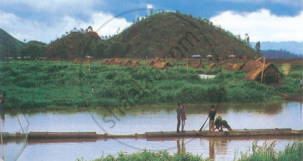Topics
India and the Contemporary World - 1
The French Revolution
- Introduction of the French Revolution
- French Society During the Late Eighteenth Century
- The Outbreak of the Revolution
- France Abolishes Monarchy and Becomes a Republic
- Did Women Have a Revolution
- The Abolition of Slavery
- The Revolution and Everyday Life
Socialism in Europe and the Russian Revolution
- The Age of Social Change
- The Russian Revolution
- The February Revolution in Petrograd
- What Changed After October?
- The Global Influence of the Russian Revolution and the USSR
Nazism and the Rise of Hitler
- Introduction of Nazism and the Rise of Hitler
- Birth of the Weimar Republic
- Hitler’s Rise to Power
- The Nazi Worldview
- Youth in Nazi Germany
- Ordinary People and the Crimes Against Humanity
Forest Society and Colonialism
- Introduction of Forest Society and Colonialism
- Deforestation and Its Causes
- The Rise of Commercial Forestry
- Rebellion in the Forest
- Forest Transformations in Java
Pastoralists in the Modern World
- Introduction of Pastoralists in the Modern World
- Pastoral Nomads and Their Movements
- Colonial Rule and Pastoral Life
- Pastoralism in Africa
Contemporary India - 1
India - Size and Location
Physical Features of India
Drainage
- Drainage
- Drainage Systems of India
- Himalayan Rivers
- Characteristics of Himalayan Rivers
- Peninsular Rivers
- Characteristics of Peninsular Rivers
- Lakes
- Role of Rivers in the Economy
- River Pollution
Climate
- Climate
- Climate of India
- Climatic Controls
- Factors Affecting the Indian Climate
- The Indian Monsoon
- The Onset of the Monsoon and Withdrawal
- Seasons of India
- The Winter Season or Cold Weather
- The Summer or Hot Weather Season
- Southwest Monsoon or Rainy Season
- Northeast monsoon season or Retreating Monsoon
- Distribution of Rainfall
- Monsoon as a Unifying Bond
Natural Vegetation and Wildlife
Population
Democratic Politics - 1
What is Democracy? Why Democracy?
- What is Democracy?
- Features of Democracy
- Why Democracy
- Broader Meanings of Democracy
Constitutional Design
- Democratic Constitution in South Africa
- Why Do We Need a Constitution?
- Making of the Indian Constitution
- Guiding Values of the Indian Constitution
Electoral Politics
- Why Elections?
- What is Our System of Elections?
- What Makes Elections in India Democratic?
Working of Institutions
- How is a Major Policy Decision Taken
- Parliament
- Political Executive
- The Judiciary
Democratic Rights
- Life Without Rights
- Rights in a Democracy
- Rights in the Indian Constitution
- Expanding Scope of Rights
Economics
The Story of Village Palampur
- Introduction of the Story of Village Palampur
- Organisation of Production
- Farming in Palampur
- Non-farm Activities in Palampur
People as Resource
- Introduction of People as Resource
- Economic Activities by Men and Women
- Quality of Population
- Unemployment
Poverty as a Challenge
- Introduction of Poverty as a Challenge
- Two Typical Cases of Poverty
- Poverty as Seen by Social Scientists
- Poverty Estimates
- Vulnerable Groups
- Inter-state Disparities
- Global Poverty Scenario
- Causes of Poverty
- Anti-poverty Measures
- The Challenges Ahead of Poverty
Food Security in India
- Food Security
- Food Insecure
- Food Security in India
- Buffer Stock
- Public Distribution System
- Current Status of the Public Distribution System
- Role of Cooperatives in Food Security
Disaster Management
Notes
Lakes
|
Loktak Lake |
- There are numerous lakes in India. These differ from each other in terms of size and other characteristics.
- Most lakes are permanent, but some, such as those in semi-arid inland drainage basins, only contain water during the rainy season.
- Lakes are formed by the action of glaciers and ice sheets, wind, river, and human.
- A meandering river across a floodplain creates cut-offs, which eventually develop into ox-bow lakes. Spits and bars form lagoons along the coast, such as the Chilika, Pulicat, and Kolleru lakes.
- Lakes in the inland drainage region are sometimes seasonal, such as the salt water Sambhar lake in Rajasthan. Its water is used to make salt.
- The Himalayan region contains the majority of freshwater lakes. They are glacial in origin. In other words, they formed when glaciers dug out a basin that was later filled by snowmelt. In contrast, the Wular lake in Jammu and Kashmir is the result of tectonic activity. It is India's largest freshwater lake.
- Other notable freshwater lakes include Dal Lake, Bhimtal, Nainital, Loktak, and Barapani.
- Besides natural lakes, damming rivers for hydropower generation has resulted in the formation of lakes such as Guru Gobind Sagar (Bhakra Nangal Project).
- Lakes are extremely valuable to humans. A lake helps to control the flow of a river. It prevents flooding during heavy rains and aids in maintaining an even flow of water during the dry season. Lakes can also be used to generate hydropower.
- They help to maintain the aquatic ecosystem, enhance natural beauty, develop tourism, and provide recreation.
| Sr. No. | Natural Lakes | Artificial Lakes |
| 1. | Wular lake, Jammu and Kashmir | Bhimtal Lake, Nainital city |
| 2. | Dal lake, Srinagar | Barapani, Shillong |
| 3. | Nainital lake, Uttarakhand | Vembanad lake, Kerala |
| 4. | Loktak Lake, Manipur | Rudrasagar lake, Tripura |
| 5. | Chilika Lake, Odisha | |
| 6. | Sambhar Lake, Rajasthan | |
| 7. | Pulicat Lake, boundary of the Andhra and Tamil Nadu coasts | |
| 8. | Kolleru Lake, between the Krisha and Godavari delta | |
| 9. | Lonar lake, Maharashtra |
Do you know?Lakes of large extent are called seas, like the Caspian, the Dead and the Aral seas. |
If you would like to contribute notes or other learning material, please submit them using the button below.

